EVERYONE has been asking my thoughts on Tiger King. I’m a wildlife biologist with 17 years of experience and a long personal history of doing research on animals in captivity. In fact, because it’s currently spring break, I’ve already been blogging a lot about animal selfies, elephant rides, and sham sanctuaries (although this year no one is going because of COVID-19).
Tiger King is a docuseries on Netflix that explores the true crime story between two enemies: animal park owner “Joe Exotic” (Joseph Maldonado-Passage) and big cat sanctuary founder Carole Baskin. The premise is that Baskin wants to make it illegal for the private ownership and breeding of big cats, which therefore threatens Joe Exotic’s entire livelihood.
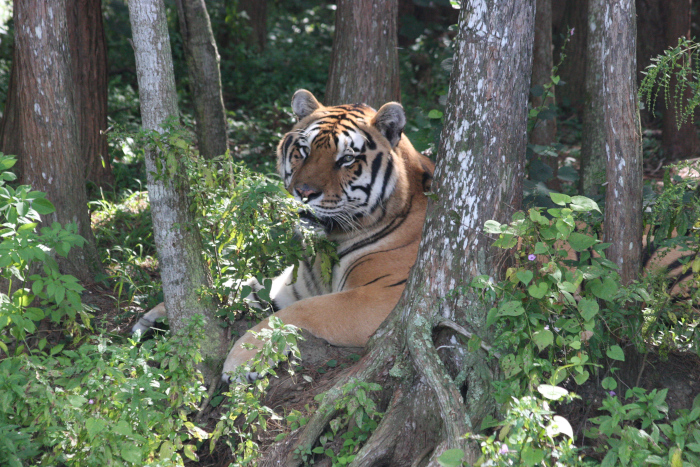
The series focuses on the true crime story between the main characters, but set in the context of private zoos and sanctuaries. The film does not take a clear side on the facilities in Tiger King. Both parties present both arguments against each other and it’s up to you to decide.
However, people featured in the film lie (in fact in the Wondery Podcast, Rick Kirkham said Joe lied even about having cancer), making it difficult for you to get an accurate understanding of what’s really going on. They throw around the word conservation without ever really explaining how their zoos or sanctuaries contribute to conservation of these big cats in the wild.
I’m here to help you all navigate this. I’ve organized my professional opinions on the facilities featured on the Netflix show Tiger King and listening to Wondery’s podcast Joe Exotic. I’ve been working in the field of animal conservation since 2013 and worked at a zoo (Disney’s Animal Kingdom) and an AZA accredited museum (North Carolina Museum of Natural Sciences). My Ph.D. focused on animal behavior and conservation genetics.
I’ve evaluated the facilities based on their contributions to conservation, education, and their animal welfare standards. I have not been to these facilities. My opinions are based on what I’ve seen from the documentary and the reporting from the podcast. Please read my blog post on zoos to understand the real ways that zoos contribute to conservation and education.
This is not about Carole Baskin. It is only based on what I think of the sanctuary based on the documentary, podcast, and doing some online research. My intention is to provide people with information so they can critically think through if the zoos or sanctuaries they visit are ethical.
First up, Big Cat Rescue…
Big Cat Rescue (Carole Baskin’s Big Cat Sanctuary)
This is only about Big Cat Rescue. I am focusing on Big Cat Rescue in terms of their contributions to conservation, education, and animal welfare standards.
Is Carole Baskin a Hypocrite?
Probably the question I get most frequently asked about Carole’s facility, the Big Cat Rescue, is: Is Big Cat Rescue just as bad as the zoos featured? Isn’t Carole doing the same thing?
In fact, in episode two, Rick Kirkham says “Carole is just as bad as Joe. They were both taking advantage of animals to make money.”
Let me address this very clearly: No!!!!!!!!! Definitely not.
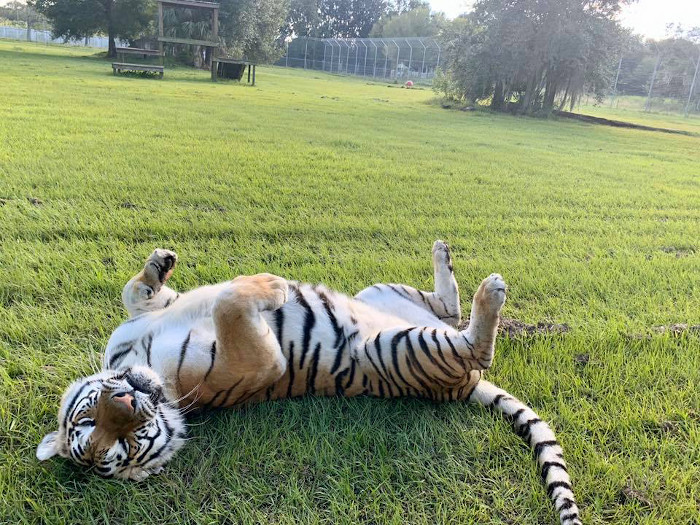
The Big Cat Rescue is a million times better than the zoos featured in the program (check out my review of Joe Exotic’s Zoo and Myrtle Beach Safari. The biggest difference is as the documentary mentioned, the breeding of big cats. Just because an animal is an endangered species, does not mean that breeding it will help its conservation in the wild.
There are currently more captive tigers in the US than there are in the wild. These cats will never be released to the wild and AZA accredited zoos maintain genetically viable captive bred tigers, making any of these other breeding efforts unnecessary. You can read the full explanation in this post and recently another scientist wrote about this here.
Carole USED to be as bad as these zoo owners in the documentary. She USED to breed some species of exotic cats, but then she stopped. I am sure that some of her cats may be ones that she bred from her past, which is why this is confusing. As long as she doesn’t breed and advocates for the stopping of breeding, this is so much better than zoos that breed constantly.
However, the fact that she is no longer breeding and now taking in cats from other places such as roadside zoos, private individuals, and circuses, makes her better. She is also working to change laws to make big cat breeding for private individuals illegal, which would solve the problem of all of these big cats needing places to go.
Sanctuaries exist because people cannot take care of these animals for one reason or another. For example, where are you going to put a tiger found in a New York City apartment? Lots of zoos won’t take animals hand-raised by humans.
People get tiger cubs as pets, they grow up, then they can’t handle them anymore. This is why sanctuaries are needed.
Carole says in one clip that she thinks that big cats do not belong in big cages – this means that she should want her sanctuary to end if she gets her way with legislation. Theoretically, she should want to end her own sanctuary.
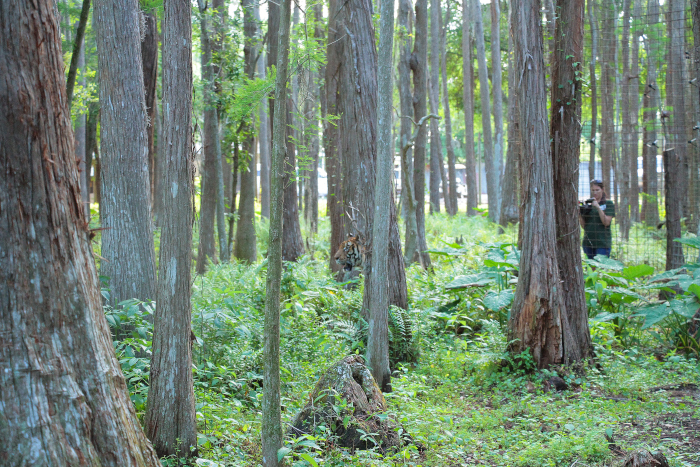
Is Carole Using Big Cat Rescue to Become Rich?
In the documentary, Doc Antle says that “Carole wants to be the last man standing – it can be only her.” But Carole works with PETA and PETA is ultimately against animals in captivity. Because PETA understands that Big Cat Rescue is a non-profit sanctuary and against big cat breeding, that is why they support her; they know she is trying to stop that practice.
It doesn’t make sense for PETA to support her and for Carole to support legislation that would end big cat breeding if she were in it as a business to exploit big cats. It also doesn’t make sense for Carole to be aggressively trying to stop the breeding of big cats. Ultimately, that is where cats at the sanctuary come from.
Carole makes a little over $60,000 a year. The sanctuary is a non-profit and you can look up all of the financial information (like salaries) on the IRS forms found here. It doesn’t make sense for her to use the sanctuary to get rich because she already had millions from her real estate business and she is actively working on legislation to end big cat breeding. If that were to take into effect, there would be fewer and eventually no big cats to rescue, and her facility would eventually close down.
Update: I just finished the Wondery podcast (released today) and they included a clip of Carole saying that that is exactly what she wants – for no big cat to ever be in a cage and for her place to eventually shut down.
Now let’s talk about conservation, education, and animal welfare at Big Cat Rescue…
Conservation at Big Cat Rescue
Everyone in Tiger King threw around the word conservation. Conservation describes research and actions to try to save the species in the wild. Yet, as we saw from the documentary, there was not much tangible discussion about tigers or other animals in the wild. Really, it was only mentioned at the end of the documentary.
In an interview with the directors, Goode said “…There was a lack of intellectual curiosity to really go and understand or even see these animals in the wild. Certainly, Carole really had no interest in seeing an animal in the wild…. The lack of education, frankly, was really interesting — how they had built their own little utopias and really were only interested in that world and the rules they had created.”
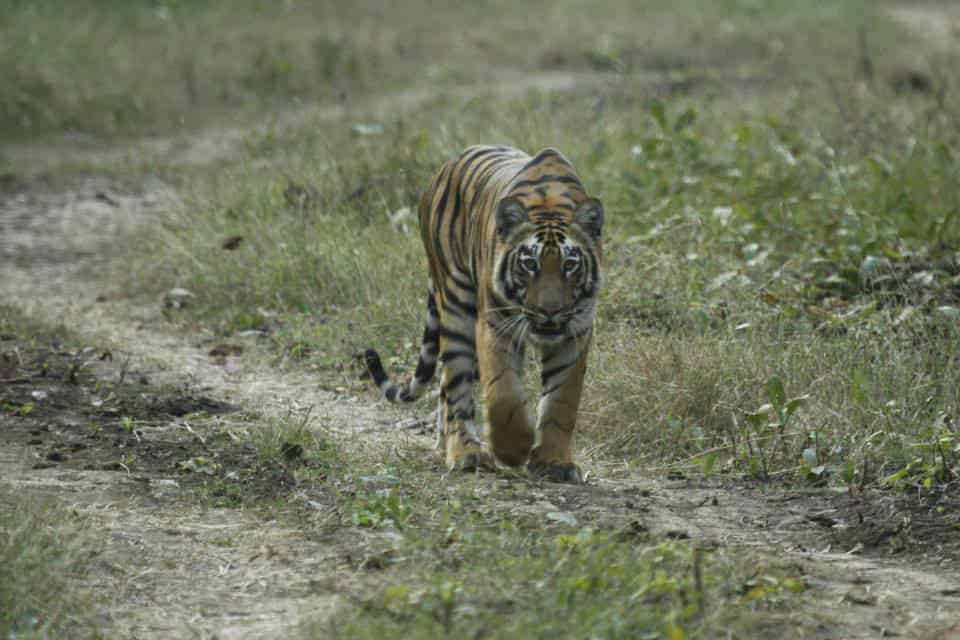
That may be true, but I personally think Carole’s focus was on stopping the breeding/cub-petting in the United States, which is not a conservation issue, but an animal welfare one. In fact, she said in the Netflix Tiger King series that she believes you can do one thing in life and your focus should be on one thing. Stopping big cat breeding was her one thing and I think she didn’t want to spread her energy thin working on too many things.
Update: Carole Baskin herself contacted me about this post and shared with me that the reason she wasn’t as interested in a safari to see the big cats in the wild is because she was worried it would make her job at the sanctuary harder. She feared she would constantly think about how unfair it is to all of the cats living in cages that they can’t be released to the wild.
That being said, Big Cat Rescue does do conservation work, even if Carole personally expressed no interest in going to see the animals in the wild. I care about conserving polar bears even though I’ve never been to the Arctic (although I would love to go).
Sanctuaries don’t necessarily do conservation work. They give forever homes to animals from abusive or neglected backgrounds, which does not contribute to conservation in the wild. However, some sanctuaries do support conservation work either indirectly or directly.
It looks like BCR donates tens of thousands to hundreds of thousands of dollars every year to conservation organizations. Some of the amounts they disclosed on this page, while others they did not. They do however report exact numbers in their annual reports. In 2019, they donated $136,600 USD to cats conservation in their native range.
The form you have selected does not exist.
These conservation organizations conduct research on cats in the wild as well as provide support to reduce their threats such as anti-poaching efforts. I am familiar with some of the organizations listed and they are legit and do great conservation work.
In addition to funding conservation projects, they do take in and rehabilitate bobcats and release them back into the wild. Although this is definitely a nice thing to do, it won’t help conservation.
Bobcats are amazing, but they are a species of least concern; they are not threatened or endangered. It’s analogous to rehabilitating squirrels or raccoons (which again, is a very nice thing to do). Also, unless these animals are tracked after release, we don’t know if they survive. It’s possible Big Cat Rescue could be spending hundreds to thousands of dollars rehabilitating bobcats that even after their injuries heal, do not survive in the wild.
One of the ways that sanctuary animals can help out the conservation of their wild counterparts is by acting as “ambassador animals.” When the public sees animals at Big Cat Rescue, they may be more inspired to donate to organizations that research and conserve these animals in the wild.
Given that feeding sanctuary animals costs a lot of money, some people argue that spending money on conservation efforts might be a better use of money. For example, rather than have 20 tigers alive as ambassador animals ($200,000 a year to feed), you could have five ($50,000 a year), but still try to raise as much money as you would to feed the 20. This would mean people would have to euthanize otherwise healthy captive exotic animals, which of course is really sad.
Big Cat Rescue also receives a significant amount of money from grants. Grants are not easy to get and require you to thoroughly explain what you are spending your money on, how it will help conservation, education or animal welfare. This increases their credibility as a non-profit.
Education at Big Cat Rescue
According to Big Cat Rescue’s 2019 annual report, staff visited 27 schools to talk about the animals at Big Cat Rescue, their mission, cub petting, and how people can help conserve the animals in the wild. They also have some virtual platforms for teachers. As you saw in the documentary, they obviously have tens of thousands of visitors a year, and I assume they offer educational information on these tours (although I can’t say 100% for sure).
It seems like most of their education is focused on big cats in captivity (and not necessarily conservation or science), but again, I don’t know. They do not seem to have educational information on the species of animals they have at their sanctuary on their website, but they do have profiles of the animals and where they came from.
Animal Welfare at Big Cat Rescue
Aren’t the Cages Small?
This is the second biggest misconception about Big Cat Rescue. In one of the scenes featuring Joe Exotic’s Internet show, he accused Carole of having small cages. He holds out his hand and says something like look at this. “That mountain lion is sticking its head through a hole in the fence to drink water.” It was actually a lynx or a bobcat though – not a mountain lion.
Yes, it was sticking its head in a small hole, but THIS IS NOT THE WHOLE ENCLOSURE! Sorry for yelling.
These small “cages” like the one below are the “lockout” section of a much larger enclosure. There is a moving door in between so they can temporarily put the animals in the small cage, while they clean the much larger enclosure. These lockout areas protect the volunteers from the big cats. You can read more about their cages here.
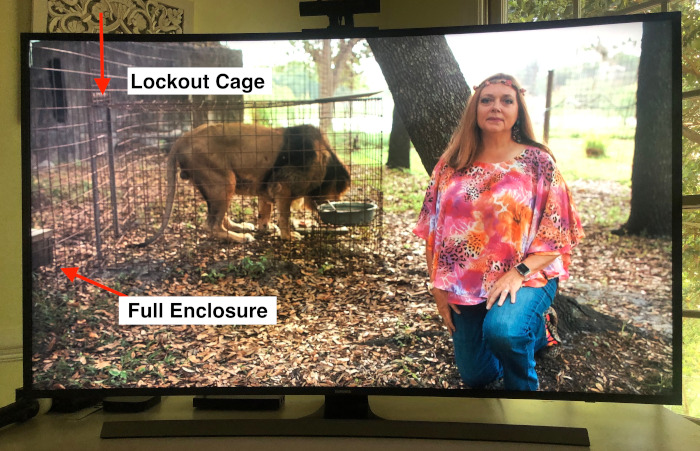
At one point, Joe Exotic said the cages were rusted, but I think it’s just the paint on the cage as you can see in the photo below.
Another concern was that Carole was kind of like a big cat hoarder and had lots of animals. I was imagining she had like a hundred tigers. But as of 2019, Big Cat Rescue has 58 animals, 10 of which are tigers. The enclosures range from 1,200 square feet to 2.5 acres according to the cats’ size (smaller cats have smaller cages). You can see the tigers have a lot of space from the photo below.
Joe does show videos of the cages being overgrown in the documentary, which I personally don’t think is a problem because it gives the cats more habitat structure and that they are small. There is one scene with a tiger is in a cage that looks small, but this might be a portion of the enclosure. It’s hard to tell.
Big Cat Rescue’s tiger cages are much larger than those recommended by the Association of Zoos and Aquariums, so if you think those are small, then you should also be advocating that the AZA increase their standards.
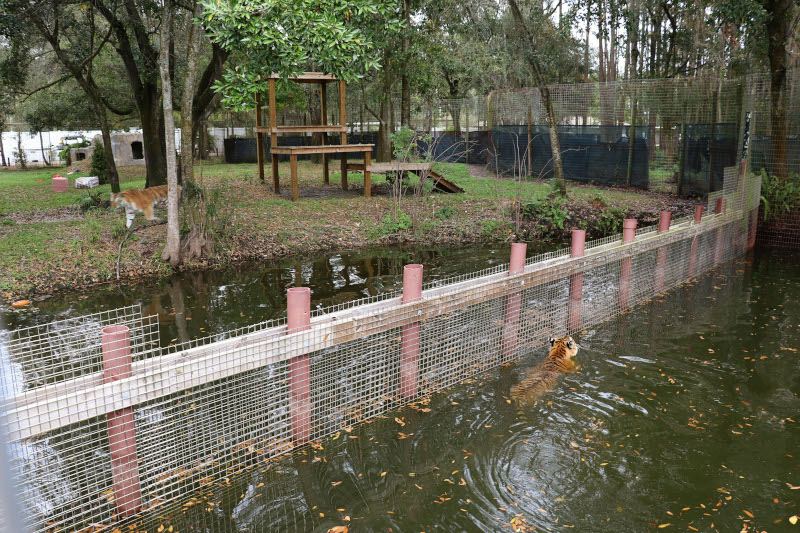
Big Cat Rescue allows visitors, which could potentially stress the animals out. According to their website, they raise their prices to keep it under 28,000 people. But they also report numbers up to 30,000 on the website.
The only bad thing I could find on Big Cat Rescue was a couple of incidences of them poking a bobcat and a tiger to get them to move between cages. This is from a site run by Doc Antle and in my opinion didn’t look like that big of a deal. I watched the videos and it did not look like animal abuse.
This website has a full listing of all of the alleged abuses. Again, I don’t see anything serious here. For example, a serval was found with a broken leg in its cage. My dog randomly strained her shoulder and my husband and I have no idea how it happened! We take amazing care of her.
The biggest problems were from her past – obviously the breeding and it looks like she declawed cats which is awful.
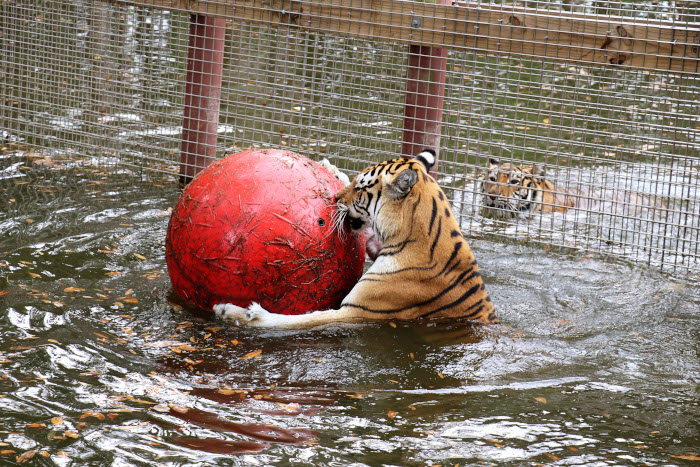
Other Concerns
In the series, an informant wanted to take Carole down and turned over a massive amount of documents to Joe Exotic. I did find that strange and wondered why they wanted to take her down, but nothing seemed to come of it in terms of animal abuse. We didn’t hear anything specific. All of the accusations on Big Cat Rescue Watch are things that Big Cat Rescue discloses (for example on their Facebook page).
Really my only other concern was her voluntary staff. On Big Cat Rescue’s website, they have 18 full time staff, but no professional keepers. I found that odd, but given her experience handing captive big cats herself, maybe that is why. Maybe she considers herself the head keeper.
She even said “I don’t pay people for animal care because people will do that for free.” I am sure experienced people volunteer their time, but I do think she should have at least one full time person for animal care.
I don’t have a problem with her using volunteers for animal care. In the documentary, she explained that they had to work their way up before doing any work involving the cats and that seems very reasonable and responsible.
So that’s it! I know lots of people personally dislike Carole, but it’s really unfair to say that Big Cat Rescue is anything close to Joe’s or Doc’s Zoo. From everything I can see, it is a legit non-profit sanctuary taking in unwanted big cats. You can also check out Big Cat Rescue’s rating on Charity Navigator, an independent organization that evaluates charities on things like transparency and finances. In fact, Big Cat Rescue has the highest score possible.
Love this post? Share it with friends!


